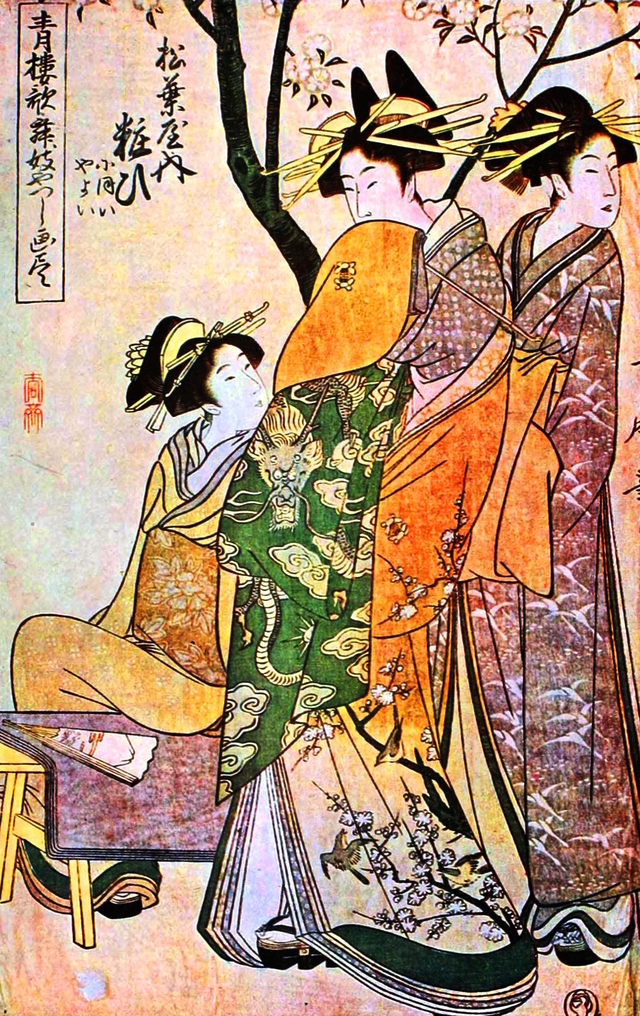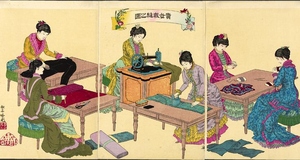Women in Ancient Japan: From Matriarchal Antiquity to Acquiescent Confinement
By
2010, Vol. 2 No. 09 | pg. 1/1 The role of women in ancient Japan elicits inconsistencies due to different influences that were integrated at various time periods. The primary influence that contributed to these inconsistencies was religion. Integration of the two major religions of Japan, Shintoism and Buddhism, created a paradox for the female identity; altering women’s place in Japan’s matriarchal antiquity to a state of acquiescent confinement by the dawn of the Meiji Restoration. Different conjectures of ancient Japanese women were formed in direct correlation to the spiritual beliefs of the time. Evaluating the feminine identities educed by these beliefs illustrates the drastic changes that occurred for women. Through literature and written records a window to the past is created, allowing modern day analysis on the status of women in antiquated Japan. Historian Dr. Joyce Lebra along with colleague Joy Paulson provides the primary historiography pertaining to the role of women in Japanese society, setting the foundation for this argument. The Kojiki and Nihongi are the two original Japanese written records that illuminate the first documented Japanese attitude towards women.i These documents facilitated the discovery of a feminine presence that is renowned and worshipped. The Nihongi holds insight into the birth of Shinto though the story of Amaterasu, which was previously preserved by oral tradition.ii Amaterasu is portrayed as the epitome of perfection in the Shinto religion exemplifying intelligence, beauty, fertility, and purity.iii As the Sun Goddess, Amaterasu is the primary kami of worship and her feminine qualities are embraced and admired. This mythology based on femininity, created a “matriarchal antiquity” in Japan.iv The mythology surrounding Amaterasu was not only the birth of the Yamato line, but of a feminine allure that would dictate a reputable attitude towards women until the sixth century. Chinese records dating back to the first century reveal that women were not only allowed to rule, but also encouraged to rule due to a confidence in women to bring peace and regulation to the country.v In these documents it is determined that a female ruler Pimiko ruled Japan in the third century. She was described as having “mature eyes.” In the same document the opinion of women is established, “Women are chaste and not given to jealousy.”vi When Pimiko’s female descendant, Iyo, became queen she was greeted with much support from the people.vii This instance of historical record illustrates themes that parallel in the Shinto mythology during a time when Shinto was the primary religion. A women’s sense of order and perfection is reflected in both documents. What Amaterasu represents is personified in Pimiko and Iyo. Dr. Lebra confirms,“ From the depictions of female deities in the myths and the numerous women rulers…it can be assumed that the status of women was similar to that of men.”viii In 552 A.D the introduction of Buddhism from China would interfere with the Shinto dominated perception of women.ix According to Dr. Lebra and Joy Paulson, “The aspects of Buddhism which define its character had begun to make inroads on society’s attitude towards women.”x This particular form of Buddhism that assimilated in Japan was immensely anti-feminine.xi Japan’s newfound Buddhism had fundamental convictions that women were of evil nature, which eventually led women into a submissive role of in Japanese society. The concept of obtaining enlightenment was limited to men, “…man is the personification of the Buddha.”xii In certain sects of Buddhism it is diplomatically implied that the only way for a woman to reach salvation is if she were reincarnated as a man.xiii Teachings even went as far as to associate woman as “agents of the devil” to seduce men away from obtaining Buddahood.xiv These spiritually based judgments produced a chauvinistic society. These spiritual attitudes can be found in the literary works of the time. The thirteenth century Buddhist morality tale The Captain of Naruto emphasizes the concept of female submission and male dominance. In the tale a wife of a captain is the object of the emperor’s desire.xv The captain orders his wife to go to the emperor and she agrees, illustrating an act of submission. The Tale of Genji also provides examples of Buddhist values. Genji imitates the Buddhist credence of the time, Heian Japan, by stating, “If they were not fundamentally evil they would not be born a woman at all.”xvi Lady Murasaki, the author, illustrates the use of women for political advancement through marriage throughout the plot line.xvii This mirrors the common use of woman during the Fujiwara dominance; to form political alliances obtained through arranged marriages made by fathers.xviii Once again the Buddhist perception of women was fueling the deterioration of their status in society. The negative Buddhist depiction of women infiltrates the story of Genji as well as reflects the common marriage practices of the time. Again historical record and literature are sharing common themes. The Heian period is known for its developments in literature, attributed to the woman authors such as Murasaki.xix During this time women faced severe isolation with limited education.xx Women in the Heian period were defined by restrictions of what was not permitted.xxi Custom influenced by Buddhism, enforced strict physical limitations on women, not to be seen by men and sometimes even other women.xxii In a diary entry of an aristocratic woman, Izumi Shikibu, a poem is entered: Thinking of the world This entry illustrates the frustrations of her confinement. These women were locked away from the world, with nothing else to do but think and imagine a world outside the walls of their detainment. Nevertheless, in their time of internment these aristocratic women had a literary revolution brewing. Although they did not openly acknowledge their education many aristocratic Heian women learned to write eloquently. Lady Muraskai is a prime example of women writers whom were self taught, and she composed the first novel in Japan, The Tale of Genji. In a dairy entry Lady Muraskai acknowledges learning the Chinese classics from listening to her brother’s lessons.xxiv She cautiously expresses the necessity for discretion in regards to her knowledge, since this education was restricted for women, again a product of preconceived prejudices against women due to the Buddhist convictions. The development of feudal Japan during the Kamakura period distinctly outlined the expectations of women.xxv Dr. Lebra declares, “In this less structured society the freedom and strength of women grew, and the Kamakura period became a high point in the status of Japanese women.”xxvi Women were playing a more active role in society, reconnecting from behind the Heian barriers. Women even trained in the ways of the samurai, although there were still property and financial restrictions to their status.xxvii Buddhism was flourishing due to the introduction of new sects of Buddhism, like Amidism, which were far more harmonious and less restrictive to women.xxviii In this case Buddhism is contradicting itself, creating inconsistencies in the expectations of women. As the feudal era progressed, and relations became more hostile, women’s rights began to revert again. The husband and wife relationship began to reflect that of the lord and subject feudal ideal.xxix During the Tokugawa era the definition of women was clear, “marriage was the only acceptable condition for women. Thus the sole purpose should be learning to please her future husband…”xxx Households were again based on patriarchy, and women once again detained from other women and considered “shallow” in intelligencexxxi. Ieyasu Tokugawa wished to freeze social classes and human relations for control and unity purposes, thus resorted to old restrictive customs of women, originally instated due to the Buddhist chauvinism.xxxii This restrictive lifestyle defined the status of women leading up to modern day Japan.xxxiii Counterarguments claim it is difficult to define ancient Japanese women’s status due to the lack of resources regarding the lower class. Unfortunately a disadvantage when exploring this topic is the limited resources from men and women of the lower class.xxxiv Most diary entries and literary works, especially during the Heian period, were the products of Aristocratic women. However, these two central religions in Japan bridge the gap between classes sharing common beliefs and ritual, which are the focal influences under examination. Another criticism is that Shinto is hard to define due to its hybrid tendencies.xxxv The vindication, Amaterasu’s role in Shintoism as the premier deity is indisputable, and is supported by Chinese historical record as well as Japanese mythology. The anti-feminine tendencies of Buddhism redefined the role of women and continually progressed and regressed over a period of thirteen hundred years. There is an evident change of femininity and matriarchy at the dawn of Japanese civilization to the restricted and submissive women of the Tokugawa era that was “devoid of legal rights,” by the birth of modern Japanxxxvi. This change can be attributed to the arrival of Buddhism in 552, creating a paradox with the native Shintoism. The two religions were harmonious in practice yet created a contradictory and confusing role for the women of ancient Japan. The Heian women themselves were a contradiction; in their confinement they found liberation in writing which would be a dynamic contribution to Japanese culture, and their legacy. The status of women in ancient Japan was interrupted, due to the chauvinistic foundation that Buddhism conveyed. Joy Paulson confirms, “…their status was defined by custom.” xxxvii ReferencesHenshall, Kenneth. A History of Japan: From Stone Age to Superpower. 2nd ed. New York: Palgrave Macmillan, 2004. Lebra, Joyce, Joy Paulson, and Elizabeth Powers,ed. Women in Changing Japan. Boulder: Westview Press, 1976. Lu, David J. Japan: A Documentary History. New York: M.E. Sharpe Inc., 1997. Shikibu, Murasaki. The Tale of Genji. Translated by Arthur Waley. The Modern Library Edition. New York: Random House, 1960. Hooker, Richard. “ Women and Women’s Communities in Ancient Japan.” Washington State University. http://www.wsu.edu:8080/~dee/ANCJAPAN/WOMEN.HTM. Moua, J.C, and Seth Tabor. “Amaterasu Omikami: Great Goddess Shining in Heaven.” University of Wisconsin. http://www.uwec.edu/philrelshimbutsudo/amaterasu. html. Omori, Annie and Kochi Doi. “Court Ladies of Old Japan.” Boston: Houghton Mifflin Company, 1920. University of Pennsylvania. http://digital.library.upenn.edu/ women/omori/court/court.html. Endnotesi.) David J. Lu, Japan: A Documentary History, New York: M.E. Sharpe Inc., 1997, 3-4. ii.) . J.C Moua and Seth Tabor, “Amaterasu Omikami: Great Goddess Shining in Heaven,” University of Wisconsin, http://www.uwec.edu/philrelshimbutsudo/amaterasu.html/. iii.) Joyce, Lebra, Joy Paulson, and Elizabeth Powers, ed., Women in Changing Japan, Boulder: Westview Press, 1976, 2. iv.) Ibid. v.) Lu, 13. vi.) Ibid. vii.) Ibid, 14. viii.) Lebra, 4. ix.) Richard Hooker, “ Women and Women’s Communities in Ancient Japan,” Washington State University, http://www.wsu.edu:8080/~dee/ANCJAPAN/WOMEN.HTM x.) Lebra, 7. xi.) Ibid. xii.) Ibid, 9. xiii.) Ibid. xiv.) Ibid. xv.) Ibid, 8. xvi.) Murasaki Shikibu, The Tale of Genji, Trans, Arthur Waley, The Modern Library Edition, New York: Random House,1960, 666. xvii.) Ibid. xviii.) Kenneth Henshall, A History of Japan: From Stone Age to Superpower, 2nd ed. New York: Palgrave Macmillan, 2004, 29. xix.) Lebra, 209. xx.) Lu, 66. xxi.) Lebra, 7. xxii.) Ibid, 6. xxiii.) Annie Omori and Kochi Doi, “Court Ladies of Old Japan,” Boston: Houghton Mifflin Company,1920, University of Pennsylvania,. http://digital.library.upenn.edu/women/omori/court/court.html, 152. xxiv.) Lu, 71. xxv.) Lebra, 7. xxvi.) Ibid. xxvii.) Ibid, 9. xxviii.) Hooker. xxix.) Lebra, 10. xxx.) Ibid, 10-11. xxxi.) Lebra, 11. xxxii.) Henshall, 54-55. xxxiii.) Lebra, 13. xxxiv.) Hooker. xxxv.) Ibid. xxxvi.) Lebra, 13. xxxvii.) Lebra, 4. Suggested Reading from Inquiries Journal
Inquiries Journal provides undergraduate and graduate students around the world a platform for the wide dissemination of academic work over a range of core disciplines. Representing the work of students from hundreds of institutions around the globe, Inquiries Journal's large database of academic articles is completely free. Learn more | Blog | Submit Latest in History |

















